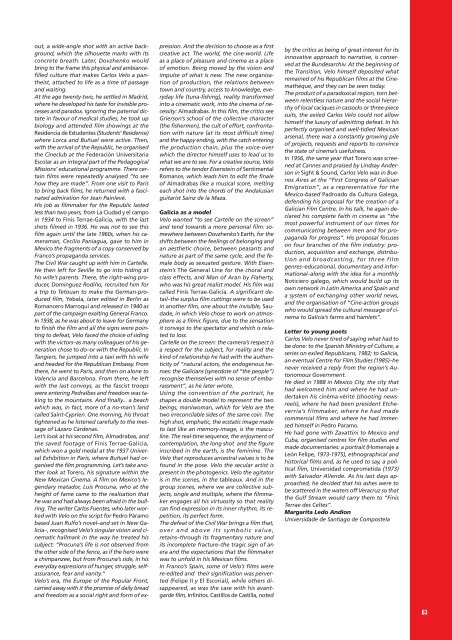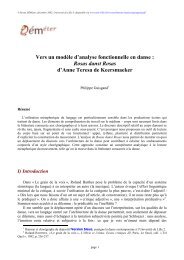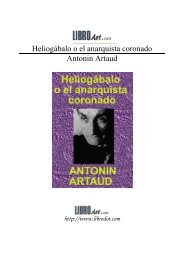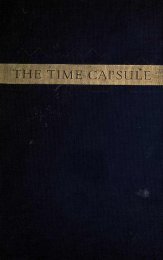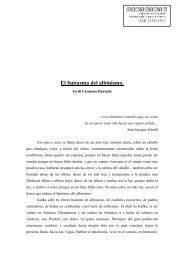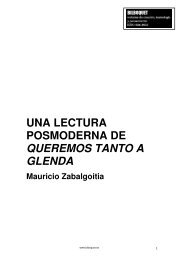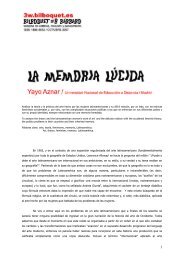07 cata 05 corr-v5 - bilboquet
07 cata 05 corr-v5 - bilboquet
07 cata 05 corr-v5 - bilboquet
- No tags were found...
You also want an ePaper? Increase the reach of your titles
YUMPU automatically turns print PDFs into web optimized ePapers that Google loves.
out, a wide-angle shot with an active background,which the silhouette marks with itsconcrete breath. Later, Dovzhenko wouldbring to the frame this physical and ambiancefilledculture that makes Carlos Velo a pantheist,attached to life as a time of passageand waiting.At the age twenty-two, he settled in Madrid,where he developed his taste for invisible processesand paradox. Ignoring the paternal dictatein favour of medical studies, he took upbiology and attended film showings at theResidencia de Estudentes (Students’ Residence)where Lorca and Buñuel were active. Then,with the arrival of the Republic, he organisedthe Cineclub at the Federación UniversitariaEscolar as an integral part of the PedagogicalMissions’ educational programme. There certainfilms were repeatedly analysed “to seehow they are made”. From one visit to Paristo bring back films, he returned with a fascinatedadmiration for Jean Painlevé.His job as filmmaker for the Republic lastedless than two years, from La Ciudad y el campoin 1934 to Finis Terrae-Galicia, with the lastshots filmed in 1936. He was not to see thisfilm again until the late 1960s, when his cameraman,Cecilio Paniagua, gave to him inMexico the fragments of a copy conserved byFranco’s propaganda services.The Civil War caught up with him in Cartelle.He then left for Seville to go into hiding athis wife’s parents. There, the right-wing producer,Dominguez Rodiño, recruited him fora trip to Tetouan to make the German-producedfilm, Yebala, later edited in Berlin asRomancero Marroquí and released in 1940 aspart of the campaign exalting General Franco.In 1938, as he was about to leave for Germanyto finish the film and all the signs were pointingto defeat, Velo faced the choice of sidingwith the victors–as many colleagues of his generationchose to do–or with the Republic. InTangiers, he jumped into a taxi with his wifeand headed for the Republican Embassy. Fromthere, he went to Paris, and then on alone toValencia and Barcelona. From there, he leftwith the last convoys, as the fascist troopswere entering Pedralbes and freedom was takingto the mountains. And finally... a beachwhich was, in fact, more of a no-man’s landcalled Saint-Cyprien. One morning, his throattightened as he listened carefully to the messageof Lázaro Cárdenas.Let’s look at his second film, Almadrabas, andthe saved footage of Finis Terrae-Galicia,which won a gold medal at the 1937 UniversalExhibition in Paris, where Buñuel had organisedthe film programming. Let’s take anotherlook at Torero, his signature within theNew Mexican Cinema. A film on Mexico’s legendarymatador, Luis Procuna, who at theheight of fame came to the realisation thathe was and had always been afraid in the bullring.The writer Carlos Fuentes, who later workedwith Velo on the script for Pedro Páramobased Juan Rulfo’s novel–and set in New Galicia–,recognised Velo’s singular vision and cinematichallmark in the way he treated hissubject: “Procuna’s life is not observed fromthe other side of the fence, as if the hero werea chimpanzee, but from Procuna’s side, in hiseveryday expressions of hunger, struggle, selfassurance,fear and vanity.”Velo’s era, the Europe of the Popular Front,carried away with it the promise of daily breadand freedom as a social right and form of expression.And the decision to choose as a firstcreative act. The world, the cine-world. Lifeas a place of pleasure and cinema as a placeof emotion. Being moved by the vision andimpulse of what is new. The new organisationof production, the relations betweentown and country, access to knowledge, everydaylife (tuna-fishing), reality transformedinto a cinematic work, into the cinema of necessity:Almadrabas. In this film, the critics seeGrierson’s school of the collective character(the fishermen), the cult of effort, confrontationwith nature (at its most difficult time)and the happy ending, with the catch enteringthe production chain, plus the voice-overwhich the director himself uses to lead us towhat we are to see. For a creative source, Velorefers to the tender Eisenstein of SentimentalRomance, which leads him to edit the finaleof Almadrabas like a musical score, meltingeach shot into the chords of the Andalusianguitarist Sainz de la Maza.Galicia as a modelVelo wanted “to see Cartelle on the screen”and tend towards a more personal film: somewherebetween Dovzhenko’s Earth, for theshifts between the feelings of belonging andan aesthetic choice, between peasants andnature as part of the same cycle, and the femalebody as sexuated gesture. With Eisenstein’sThe General Line for the choral andclass effects, and Man of Aran by Flaherty,who was his great realist model. His film wascalled Finis Terrae-Galicia. A significant detail–thesurplus film cuttings were to be usedin another film, one about the invisible, Saudade,in which Velo chose to work on atmosphereas a filmic figure, due to the sensationit conveys to the spectator and which is relatedto loss.Cartelle on the screen: the camera’s respect isa respect for the subject, for reality and thekind of relationship he had with the authenticityof “natural actors, the endogenous heroes:the Galicians (synecdote of “the people”)recognise themselves with no sense of embarassment”,as he later wrote.Using the convention of the portrait, heshapes a double model to represent the twobeings, man/woman, which for Velo are thetwo irreconcilable sides of the same coin. Thehigh shot, emphatic, the ecstatic image madeto last like an memory-image, is the masculine.The real-time sequence, the enjoyment ofcontemplation, the long shot and the figureinscribed in the earth, is the feminine. TheVelo that reproduces ancestral values is to befound in the pose. Velo the secular artist ispresent in the photogenics. Velo the agitatoris in the scenes, in the tableaux. And in thegroup scenes, where we are collective subjects,single and multiple, where the filmmakerengages all his virtuosity so that realitycan find expression in its inner rhythm, its repetition,its perfect form.The defeat of the Civil War brings a film that,over and above its symbolic value,retains–through its fragmentary nature andits incomplete fracture–the tragic sign of anera and the expectations that the filmmakerwas to unfold in his Mexican films.In Franco’s Spain, some of Velo’s films werere-edited and their signification was perverted(Felipe II y El Escorial), while others disappeared,as was the case with his avantgardefilm, Infinitos. Castillos de Castilla, notedby the critics as being of great interest for itsinnovative approach to narrative, is conservedat the Bundesarchiv. At the beginning ofthe Transition, Velo himself deposited whatremained of his Republican films at the Cinemathèque,and they can be seen today.The product of a paradoxical region, torn betweenrelentless nature and the social hierarchyof local caciques in cassocks or three-piecesuits, the exiled Carlos Velo could not allowhimself the luxury of admitting defeat. In hisperfectly organised and well-tidied Mexicanarsenal, there was a constantly growing pileof projects, requests and reports to convincethe state of cinema’s usefulness.In 1956, the same year that Torero was screenedat Cannes and praised by Lindsay Andersonin Sight & Sound, Carlos Velo was in BuenosAires at the “First Congress of GalicianEmigration”, as a representative for theMexico-based Padroado da Cultura Galega,defending his proposal for the creation of aGalician Film Centre. In his talk, he again declaredhis complete faith in cinema as “themost powerful instrument of our times forcommunicating between men and for propagandafor progress”. His proposal focuseson four branches of the film industry: production,acquisition and exchange, distributionand broadcasting, for three filmgenres–educational, documentary and informational–alongwith the idea for a monthlyNoticiero galego, which would build up itsown network in Latin America and Spain anda system of exchanging other world news,and the organisation of “Cine-action groupswho would spread the cultural message of cinemato Galicia’s farms and hamlets”.Letter to young poetsCarlos Velo never tired of saying what had tobe done: to the Spanish Ministry of Culture, aseries on exiled Republicans, 1982; to Galicia,an eventual Centre for Film Studies (1985)–henever received a reply from the region’s AutonomousGovernment.He died in 1988 in Mexico City, the city thathad welcomed him and where he had undertakenhis cinéma-vérité (shooting newsreels),where he had been president Etcheverria’sfilmmaker, where he had madecommercial films and where he had immersedhimself in Pedro Paramo.He had gone with Zavattini to Mexico andCuba, organised centres for film studies andmade documentaries: a portrait (Homenaje aLeón Felipe, 1973-1975), ethnographical andhistorical films and, as he used to say, a politicalfilm, Universidad comprometida (1973)with Salvador Allende. As his last days approached,he decided that his ashes were tobe scattered in the waters off Veracruz so thatthe Gulf Stream would carry them to “FinisTerrae des Celtes”.Margarita Ledo AndionUniversidade de Santiago de Compostela63


